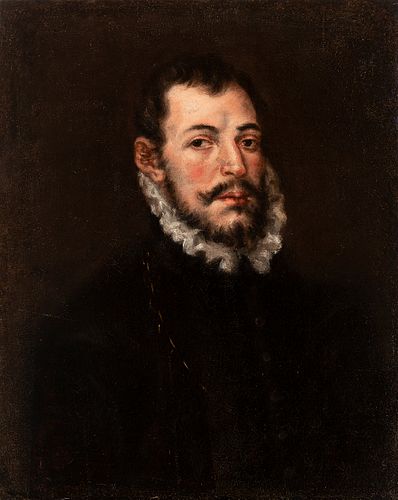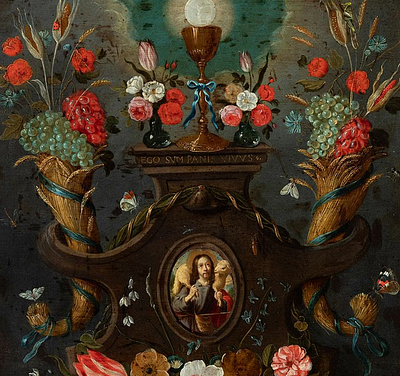Spanish school; Circle of LUIS TRISTAN (Toledo?, 1580/85 - Toledo, 1624); first third of the 17th century. "Portrait of a gentleman. Oil on canvas.
Lot 34
About Seller
Setdart Auction House
Carrer Aragó 346
Barcelona
Spain
Setdart Subastas was born in 2004 and is currently the first online art auction in Spain with solidity, prestige and reliability guaranteed by our more than 60,000 users. Setdart has a young, dynamic and enterprising team ready to successfully manage the purchase and sale of art works through custom...Read more
Estimate:
EUR€3,500 - EUR€4,000
$3,684.21 - $4,210.53
Absentee vs Live bid
Two ways to bid:
- Leave a max absentee bid and the platform will bid on your behalf up to your maximum bid during the live auction.
- Bid live during the auction and your bids will be submitted real-time to the auctioneer.
Bid Increments
| Price | Bid Increment |
|---|---|
| EUR€0 | EUR€10 |
| EUR€200 | EUR€25 |
| EUR€500 | EUR€50 |
| EUR€1,000 | EUR€100 |
| EUR€3,000 | EUR€200 |
| EUR€5,000 | EUR€500 |
| EUR€10,000 | EUR€1,000 |
| EUR€20,000 | EUR€2,000 |
| EUR€50,000 | EUR€5,000 |
About Auction
By Setdart Auction House
Sep 21, 2021
Set Reminder
2021-09-21 10:00:00
2021-09-21 10:00:00
America/New_York
Bidsquare
Bidsquare : 21st September - ARAS JÁUREGUI Private Collection - Old Masters, 19th & 20th Century
https://www.bidsquare.com/auctions/setdart-auction-house/21st-september---aras-j-uregui-private-collection---old-masters-19th-20th-century-7429
Setdart Auction House sofia@setdart.com
Setdart Auction House sofia@setdart.com
- Lot Description
Spanish school; Circle of LUIS TRISTAN (Toledo?, 1580/85 - Toledo, 1624); first third of the 17th century. "Portrait of a gentleman. Oil on canvas. Re-coloured. It has an illegible legend on the back. It has restorations and repainting. Measurements: 60 x 48 cm. In this sober portrait, the artist presents us a protagonist, who looks directly at the spectator with a serious and haughty gesture in a certain way. It seems that only the face and the ruff belong to the artist's workmanship, as the rest of the body blends in with the dark background. It is a work of a vibrant character, which forms a rosy face with truthful features and a nervous ruff, composed of spots applied with furious strokes of the brush. The aesthetic conception of this piece is reminiscent of the work in the Museo del Prado collection, "Portrait of an Old Man", attributed to Luis Tristán. Although the figures differ in age, the conception of both works is very similar, as a clear inheritance of El Greco's painting. Although it is worth noting that in this case the artist uses a direct focus of light, which falls directly on the face of the protagonist. From its formal characteristics we can link this work to a member of the workshop of Luis Tristán, one of the most outstanding representatives of the Toledo school of the early 17th century. A disciple of El Greco and Ribera in Italy, he returned to Toledo for good in 1613. His style, thanks to the heterogeneous nature of his training, is very varied, almost contradictory at times. The strong influence of El Greco will always remain in his work, especially in the elongation and expressive instability of his figures, but his direct knowledge of Caravaggism in Rome, precisely during its heyday, is reflected in a naturalism that is particularly evident in some of his works. Tristan seems to lean towards one or other style at specific moments, either by his own decision or at the behest of his clientele. The study of Venetian compositions is also evident in his language, although the clearest influence on his work is determined by the paintings that Juan Bautista Maíno left in Toledo, especially the "Portrait of the Four Easters" in the church of San Pedro Mártir, which combines Roman naturalism with sumptuous colour. All of this is reflected in works such as the set that Tristán painted in 1616 for the parish church of Yepes. He is currently represented in the Prado Museum, the El Greco Museum in Toledo, the Louvre in Paris, the Louvre in Cambridge, the Pollock House in Glasgow, the Fine Arts Museums in Budapest, Caracas, Bucharest and Seville, Toledo Cathedral and other churches in the region, the Santa Cruz Museum and the Archbishop's Palace in Toledo, the Royal Palace in Madrid and other collections and museums.
- Shipping Info
-
In-house shipping available. Please inquire at admin@setdart.com.
-
- Buyer's Premium



 EUR
EUR CAD
CAD AUD
AUD GBP
GBP MXN
MXN HKD
HKD CNY
CNY MYR
MYR SEK
SEK SGD
SGD CHF
CHF THB
THB















